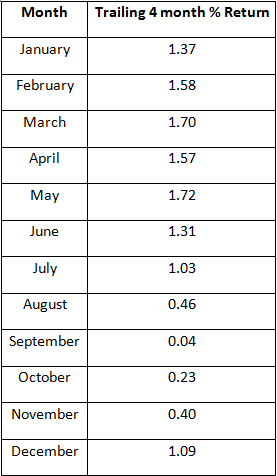The “Sell in May” seasonal trend is pretty well documented. As stocks tend to perform less well over the long run between the end of May and the end of October it should come as no surprise that this also impact various stock market sectors.
For the purposes of this test we will use the Fidelity Select Sector lineup of sector funds and look at the total monthly return for each fund on a month-by-month basis.
Figure 1 displays the following
Average% = the average monthly % total return for all Select funds for that month
Median% = the median monthly % total return for all Select funds for that month
Std Dev % = the standard deviation of monthly % total return for all Select funds for that month
Top Ave % Fund = Displays the fund that has had the highest average % total return for that month
Top Ave % = Displays the average % monthly total return for the top fund
 Figure 1 – Fidelity Select Sectors by month using total return data
Figure 1 – Fidelity Select Sectors by month using total return data
*Note that the top 7 individual months in terms of average monthly % +/- are November through May. The 5 worst performing individual months are June through October.
*For the record, it should not be assumed that simply buying and holding the “Top Ave% Fund” is necessarily the best way to go. Some of the funds such as Electronics (FSELX), Biotech (FBIOX) and especially Gold (FSAGX) can be extremely volatile.
*Also note that the top performer in the long-term for February, March and April is Energy Services (FSESX). In 2017, FSESX lost -3.6% in February, -2.5% in March and -7.9% in April. So there is no such thing as a “sure thing.”
Figure 2 displays the average trailing 4-month return for all Select Sector funds combined at the end of each month. The trailing return peaks at the end of May at +1.72% and then declines steadily into September.
Figure 2 – Average 4-month rolling return at the end of each month
Note also that the “Average” sector fund lost money overall during June, August and September.
Summary
The data contained herein serve to confirm that it is typically – though not always – tougher to make money in the stock market after the end of May.
Jay Kaeppel
Disclaimer: The data presented herein were obtained from various third-party sources. While I believe the data to be reliable, no representation is made as to, and no responsibility, warranty or liability is accepted for the accuracy or completeness of such information. The information, opinions and ideas expressed herein are for informational and educational purposes only and do not constitute and should not be construed as investment advice, an advertisement or offering of investment advisory services, or an offer to sell or a solicitation to buy any security.


